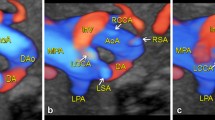Abstract
Purpose
This study aimed to report cases of high-lying azygos arch and discuss the embryological basis of its development by a thorough evaluation of the anatomical features assessed using computed tomography (CT) images.
Methods
This study was approved by our institutional review board. We retrospectively reviewed chest CT images between November 2011 and November 2018. To determine high-lying azygos arch, we set the upper margin of the T4 vertebral body as the reference level. Regarding the embryological development of high-lying azygos arch, we retrospectively reviewed the CT images of 105 patients with tracheal bronchus to identify the location of the azygos arch.
Results
We noted that on three cases CT images, the azygos arch was located higher than the upper margin of the right main bronchus, and drained into the proximal superior vena cava (SVC) at a level higher than the conventional T4 or T5 vertebral level. All 105 patients with right tracheal bronchus showed azygos arch above the tracheal bronchus.
Conclusion
This variation in the location of the azygos arch can mimic pathological lesion on plain radiographs, and, therefore, it is important to be aware of high-lying azygos arch. Our findings show that the azygos arch may have possibly migrated downward during embryological development.



Similar content being viewed by others
Data availability
Please contact authors for data requests (Jin Young Yoo, M.D—email address: immdjy@gmail.com).
Code availability
Not applicable.
References
Abrams HL (1957) The vertebral and azygos venous systems, and some variations in systemic venous return. Radiology 69:508–526. https://doi.org/10.1148/69.4.508
Drakonaki EE, Voloudaki A, Daskalogiannaki M, Karantnas AH, Gourtsoyiannis N (2008) Migratory azygos vein: a case report. J Comput Assist Tomogr 32:99–100. https://doi.org/10.1097/RCT.0b013e3180593111
Dudiak CM, Olson MC, Posniak HV (1991) CT evaluation of congenital and acquired abnormalities of the azygos system. Radiographics 11:233–246. https://doi.org/10.1148/radiographics.11.2.2028062
Lee BB (2012) Venous embryology: the key to understanding anomalous venous conditions. Phlebolymphology 19:170–181
Maldjian PD, Phatak T (2008) The empty azygos fissure: sign of an escaped azygos vein. J Thorac Imaging 23:54–56. https://doi.org/10.1097/RTI.0b013e318158e41d
Mata J, Cáceres J, Alegret X, Coscojuela P, De Marcos JA (1991) Imaging of the azygos lobe: normal anatomy and variations. Am J Roentgenol 156:931–937. https://doi.org/10.2214/ajr.156.5.2017954
Piciucchi S, Barone D, Sanna S, Dubini A, Goodman LR, Oboldi D, Bertocco M, Ciccotosto C, Gavelli B, Carloni A, Poletti V (2014) The azygos vein pathway: an overview from anatomical variations to pathological changes. Insights Imaging 5:619–628. https://doi.org/10.1007/s13244-014-0351-3
Speckman JM, Gamsu G, Webb WR (1981) Alterations in CT mediastinal anatomy produced by an azygos lobe. Am J Roentgenol 137:47–50. https://doi.org/10.2214/ajr.137.1.47
Villanueva A, Cáceres J, Ferreira M, Broncano J, Pallisa E, Bastarrika G (2010) Migrating azygos vein and vanishing azygos lobe: Mdct Findings. Am J Roentgenol 194:599–603. https://doi.org/10.2214/AJR.09.3303
Funding
Not applicable.
Author information
Authors and Affiliations
Contributions
MYY: data collection, data analysis, manuscript writing; SJK: data collection and management, data analysis, manuscript writing editing; JYY: project development, data collection and management, data analysis, manuscript writing and editing.
Corresponding author
Ethics declarations
Conflict of interest
The authors declare that they have no conflict of interest.
Ethical approval and consent to participate
The study was approved by the institutional review board and the requirement for informed consent was waived because of the retrospective study design.
Consent for publication
Not applicable.
Additional information
Publisher's Note
Springer Nature remains neutral with regard to jurisdictional claims in published maps and institutional affiliations.
Rights and permissions
About this article
Cite this article
Yoo, M.Y., Kim, S.J. & Yoo, J.Y. Cases of high lying azygos arch and its embryological consideration. Surg Radiol Anat 43, 363–366 (2021). https://doi.org/10.1007/s00276-020-02570-z
Received:
Accepted:
Published:
Issue Date:
DOI: https://doi.org/10.1007/s00276-020-02570-z




